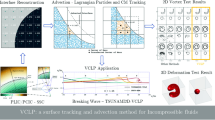Abstract
VOF method which consists in transporting a discontinuous marker variable is widely used to capture the free surface in computational fluid dynamics. There is numerical dissipation in simulations involving the transport of the marker. Numerical dissipation makes the free surface lose its physical nature. A free surface sharpening strategy based on optimization method is presented in the paper. The strategy can keep the location of the free surface and local mass conservation at both time, and can also keep free surface in a constant width. It is independent on the types of solvers and meshes. Two famous cases were chosen for verifying the free surface sharpening strategy performance. Results show that the strategy has a very good performance on keeping local mass conservation. The efficiency of prediction of the free surface is improved by applying the strategy. Accurate modeling of flow details such as drops can also be captured by this method.
Similar content being viewed by others
References
C.W. Hirt, B.D. Nichols. Volume of fluid (VOF) method for the dynamics of free boundaries. J. Comput. Phys, 1981, 39: 201–225.
E. Olsson, G. Kreiss. A conservative level set method for two phase flow. Journal of Computational Physics, 2005, 210: 225–246
L. Štrubelj et al. Simulations of free surface flows with implementation of surface tension and interface sharpening in the two-fluid model. International Journal of Heat and Fluid Flow, 2009, 30: 741–750
Steven Dufour and Ahamadi Malidi. A free surface updating methodology for marker function-based Eulerian free surface capturing techniques on unstructured meshes. Commun. Numer. Meth. Engng, 2004, 20: 857–867.
S. Aliabadi, T. E. Tezduyar. Stabilized-finite-element/interface-capturing techniques for parallel computation of unsteady flows with interfaces. Computer Methods in Applied Mechanics and Engineering, 2000, 190: 243–261.
Tu S, Aliabadi S. Development of a hybrid finite volume/element solver for incompressible flows on unstructured meshes. International Journal for Numerical Methods in Fluids, 2007, 55(2): 177–203.
Vinay R. Gopala, Berend G.M. van Wachem. Volume of fluid methods for immiscible fluid and free-surface flows. J. Chemical Engineering, 2008, 141: 204–221.
K. Abdolmaleki, K. P. Thiagarajan and M. T. Morris-Thomas. Simulation of The Dam Break Problem and Impact Flows Using a Navier-Stokes Solver. 15th Australasian Fluid Mechanics Conference, Sydney, 2004.
Zhou Z. Q., Kat J. O. D. and Buchner B. A nonlinear 3-D approach to simulate green water dynamics on deck. Nantes. 7th Intl. Conf. Num. Ship Hydrodynamics, 1999.
J. C. Martin and W. J. Moyce. An experimental study of the collapse of liquid columns on a rigid horizontal plane. Philos. Trans. Roy. Soc. London, Ser. A, 1952, 244: 312–324.
Yohei Sato, Bojan Niceno. A conservative local interface sharpening scheme for the constrained interpolation profile method. Int. J. Numer. Meth. Fluids, 2012, 70: 441–467.
K. Svanberg. A class of globally convergent optimization methods based on conservative convex separable approximations. SIAM J. Optim, 2002, 12 (2): 555–573.
Steven G. Johnson. The NLopt nonlinear-optimization packge, http://ab-initio.mit.edu/nlopt.
Author information
Authors and Affiliations
Additional information
This work was funded by National Natural Science Foundation of China, Grant number: 51176012.
Rights and permissions
About this article
Cite this article
Song, H., Ji, L. & Tu, S. A free surface sharpening strategy using optimization method. J. Therm. Sci. 24, 544–548 (2015). https://doi.org/10.1007/s11630-015-0820-0
Received:
Published:
Issue Date:
DOI: https://doi.org/10.1007/s11630-015-0820-0




